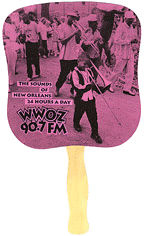Producers defy the trend against home-brewed local showsThis Briefing page gives you access to Current articles on the question of local production in public broadcasting, along with features about selected local productions.
With economics heavily favoring national and regional production, public TV and radio stations have been producing fewer and fewer programs for consumption only in their local areas, as this table indicates.
Percentage of stations' broadcast hours produced locally
Year '74 '78 '82 '86 '88 '90 '93 '94 '95 '96 Public TV Public radio Source: CPB programming surveys. CPB discontnued publishing this data after 1996 and did not collect it in some earlier years.
This trend may slow or be reversed, however, as leaders in both public radio and public TV point out that local programming is a potential competitive advantage and niche for both fields, as commercial channels increasingly come to town by satellite.
Even a brand new, small-budget public radio station, like WNAN/WCAI on Cape Cod and adjacent islands, can give itself a salty local sound by producing "sonic i.d." station break modules. (The idea came out of an imagining exercise in 1999 led by founder and independent radio producer Jay Allison.)
In Pittsburgh, WQED-FM saw the advantage in basing more programs in a new studio in the heart of the city's cultural district.
In public TV, stations can sometimes aggregate funding by developing programs that run in more than one city, like California Connected, a weekly news program for California's stations produced by a 60 Minutes veteran and anchored by David Brancaccio from public radio's Marketplace.
In terms of day-to-day economics, however, local production faces an uphill battle. Major studies, including the Boston Consulting Group report in 1991 and the Twentieth Century Fund study in 1993 suggested that public TV should invest its limited resources in high-quality national programs rather than spread them around among numerous lower-quality local productions seen by much smaller audiences. They observe that the cable TV networks like Discovery Channel, which are spared the cost of local stations altogether, reserve all their production money for national programs. Besides, many stations depend on underwriters for production funding, and underwriters show much more interest in programs (and underwriting credits) that will be seen or heard by millions rather than thousands of people.
Theorists further contend that taste and demographics create more important communities within the national population than the physical communities formed by cities or valleys or plains.
While WGBH discontinued its local nightly news program in 1991, at the time of the Boston Consulting Group report, other reacted by maintaining or improving their local output. Some, like Jack Willis, then head of the Twin Cities station, said there's little point for the existence of hundreds of autonomous stations if they don't produce substantial bodies of local programs.
Most public TV stations offer one or more weekly or monthly local programs, but a dozen, including the Twin Cities station, started a "nightly presence" of local news or public affairs. (Two of the nightly shows were canceled in 2001--in Twin Cities and Maryland.)
Others in New York, Boston, Chicago, Cleveland and elsewhere are producing regular series about local performing and visual arts, such as WNET's prize-winning City Arts (which now has a sister series, City Life). In the Philadelphia Project, WHYY is undertaking several radio and TV programs that will lead to its filming of a feature film about the city.
Local producers increasingly are trying to ride the promotional coattails of national series by doing local spinoffs for air at the same time. In several cities, local stations extended the value of Ken Burns' Jazz series in 2001 by producing shows on regional jazz scenes.
Media watchdog groups and TV critics in San Francisco, New York, Pittsburgh and elsewhere have also criticized local stations for putting their efforts into productions for national instead of local distribution.
Fan distributed by WWOZ-FM, New OrleansThese articles describe a sampling of programming made for stations' own physical communities — their communities of license, their political and economic supporters, their friends and neighbors, their homes.
- KTCA-TV, Twin Cities: Willis' station produces a nightly newscast that's "intriguing as well as just good-for-you"
- KCRW-FM, Los Angeles: a local talk show host who's a street referee, an "ombudsman of the air"
- KILI-FM, Porcupine, S.D.: a Lakota voice in the air around the reservation
- KPLU-FM, Seattle/Tacoma: a prizewinning local news source
- Nebraska ETV: a documentary series that documents the virtues of one-room schools
- Kentucky ETV: an interactive introduction to one of the state's key industries
- WWOZ-FM, New Orleans: a musical gumbo that cooks for 24 hours
- WTTW-TV, Chicago: a comic exploration of big-city life

Web page revised Aug. 6, 2002
Current
The newspaper about public television and radio
in the United States
A service of Current Publishing Committee, Takoma Park, Md.
E-mail: webcurrent.org
301-270-7240
301-270-7240
Copyright 2001-02

